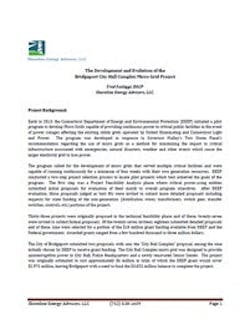Early in 2013, the Connecticut Department of Energy and Environmental Protection (DEEP) initiated a pilot program to develop microgrids capable of providing continuous power to critical public facilities in the event of power outages affecting the existing utility grids operated by United Illuminating and Connecticut Light and Power.
The program was developed in response to recommendations by Governor Dannel Malloy’s Two Storm Panel regarding the use of microgrids as a method for minimizing the impact to critical infrastructure associated with emergencies, natural disasters, weather and other events which cause the larger electricity grid to lose power.
The program called for the development of microgrids that served multiple critical facilities and were capable of running continuously for a minimum of four weeks with their own generation resources. DEEP conducted a two-step project selection process to locate pilot projects which best achieved the goals of the program. The first step was a Project Feasibility Analysis phase where critical power-using entities submitted initial proposals for evaluation of their match to overall program objectives.
After DEEP evaluation, those proposals judged as best fits were invited to submit more detailed proposals including requests for state funding of the non-generation (distribution wires, transformers, switch gear, transfer switches, controls, etc.) portions of the project.
Thirty-three projects were originally proposed in the technical feasibility phase and of these, twenty-seven were invited to submit formal proposals. Of the twenty-seven invitees, eighteen submitted detailed proposals and of these, nine were selected for a portion of the $18 million grant funding available from DEEP and the Federal government. Awarded grants ranged from a few hundred thousand to three million dollars.
The City of Bridgeport submitted two proposals, with one, the “City Hall Complex” proposal, among the nine initially chosen by DEEP to receive grant funding. The City Hall Complex microgrid was designed to provide uninterruptible power to City Hall, Police Headquarters and a newly renovated Senior Center. The project was originally estimated to cost approximately $6 million in total, of which the DEEP grant would cover $2.975 million, leaving Bridgeport with a need to fund the $3.025 million balance to complete the project.
